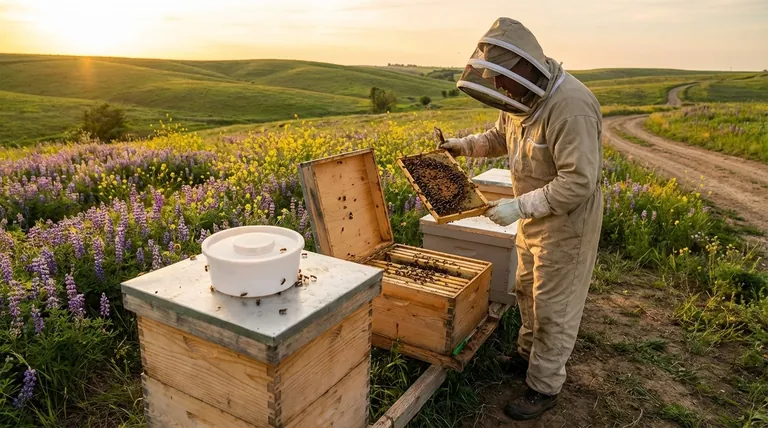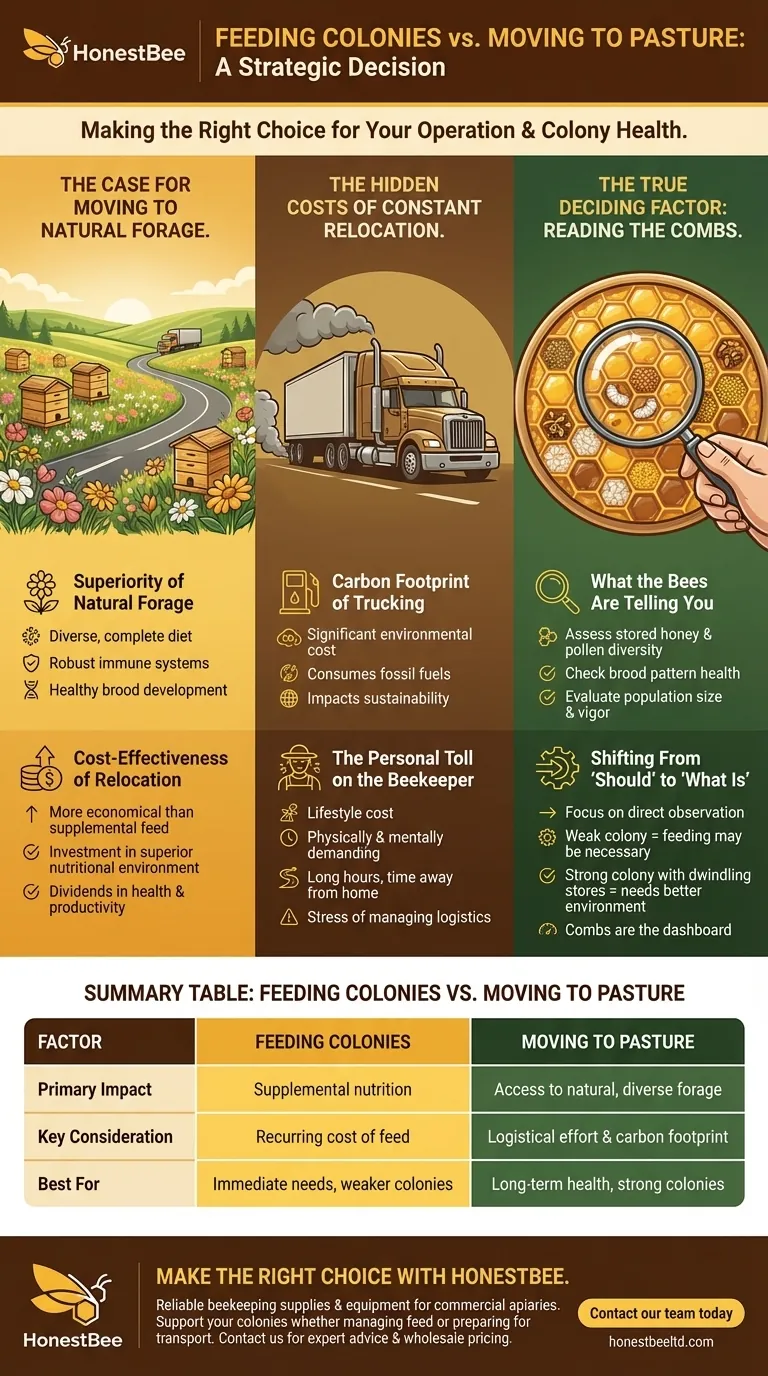The choice between feeding bee colonies or moving them to better pasture is a complex operational decision. The key factors considered include the significant carbon impact of trucking, the personal "lifestyle cost" of frequent travel for the beekeeper, and the clear biological preference for natural forage, which can often be a more cost-effective source of nutrition.
The core issue is not simply choosing the cheapest option, but learning how to interpret the colony's needs directly. The most effective beekeepers don't ask what they "should" do; they learn to read the combs and let the bees provide the answer.

The Case for Moving to Natural Forage
Moving colonies, while logistically challenging, is often considered the ideal solution because it aligns directly with the natural behavior and nutritional needs of honeybees.
The Superiority of Natural Forage
Natural forage provides a diverse and complete diet of nectar and pollen that supplemental feed cannot fully replicate. This diversity is crucial for robust immune systems, healthy brood development, and overall colony resilience.
The Cost-Effectiveness of Relocation
While trucking has its own costs, moving bees to a rich, natural nectar flow can be more economical than purchasing and administering large quantities of sugar syrup or pollen patties. It is an investment in a superior nutritional environment that pays dividends in colony health and productivity.
The Hidden Costs of Constant Relocation
The argument against moving isn't about bee health, but about the external impacts on the environment and the beekeeper's own well-being. These are practical constraints that can make feeding a necessary alternative.
The Carbon Footprint of Trucking
The environmental cost is a significant modern consideration. Transporting thousands of colonies across long distances consumes large amounts of fossil fuels, contributing to a substantial carbon footprint that weighs on the sustainability of the operation.
The Personal Toll on the Beekeeper
The "lifestyle cost" is a critical human factor. Being on the road frequently is physically and mentally demanding, involving long hours, time away from home, and the stress of managing logistics. This personal toll can impact the long-term viability of a beekeeping business.
The True Deciding Factor: Reading the Combs
Ultimately, the debate between moving and feeding is resolved by shifting focus from abstract rules to direct observation. The colony itself holds the definitive answer.
What the Bees Are Telling You
"Reading the combs" is the practice of assessing the colony's internal state. An experienced beekeeper checks for the quantity of stored honey, the diversity of stored pollen, the health of the brood pattern, and the overall population size and vigor. These are the real-time data points that should drive your decision.
Shifting From 'Should' to 'What Is'
The most valuable advice is to move past asking what you "should" do and instead focus on what the situation is. A weak colony may not be strong enough for transport, making feeding the only option. Conversely, a strong colony with dwindling stores is clearly signaling its need for a better environment. The combs are the dashboard for the hive's health.
Making the Right Choice for Your Operation
Your decision will ultimately depend on your operational priorities and what your colonies require at that specific moment.
- If your primary focus is optimal colony nutrition and long-term health: Prioritize moving to diverse, natural forage whenever it is logistically and economically feasible.
- If your primary focus is minimizing operational and environmental costs: Carefully weigh the expense and carbon footprint of trucking against the recurring cost and lesser nutritional value of supplemental feed.
- If your primary focus is sustainable beekeeping practice: Learn to interpret the state of your combs to let the bees' immediate needs, not a rigid schedule, guide your decision.
Ultimately, the most successful strategy is one that responds directly to the clear signals provided by your bees.
Summary Table:
| Factor | Feeding Colonies | Moving to Pasture |
|---|---|---|
| Primary Impact | Supplemental nutrition | Access to natural, diverse forage |
| Key Consideration | Recurring cost of feed | Logistical effort & carbon footprint of trucking |
| Best For | Immediate needs, weaker colonies | Long-term health, strong colonies |
Make the right choice for your apiary's health and your bottom line. The decision between feeding and moving is critical for commercial success. At HONESTBEE, we supply durable, efficient beekeeping supplies and equipment to commercial apiaries and distributors. Our wholesale-focused operations ensure you get the reliable gear needed to support your colonies, whether you're managing feed stations or preparing for transport. Let us help you build a stronger, more sustainable operation. Contact our team today for expert advice and wholesale pricing.
Visual Guide

Related Products
- Rapid Bee Feeder White Plastic 2L Round Top Feeder for 8 or 10-Frame Bee Hives
- HONESTBEE Advanced Ergonomic Stainless Steel Hive Tool for Beekeeping
- Professional Dual-End Stainless Steel Hive Tool for Beekeeping
- Professional 3-Bar Frame Grip with Integrated Hive Tool
- Metal Bee Hive Stand Bee Box Stand for Beekeeping
People Also Ask
- What is the best thing to feed bees? A Guide to Supplemental Feeding for a Thriving Hive
- How much honey does a strong hive need to survive winter? Ensure Your Colony's Survival (60-80 lbs)
- What are the recommended sugar-to-water ratios for making sugar syrup for bees? Optimize Your Hive's Health
- What is the advice regarding feeding bees to limit brood production based on? Managing Prolific Bee Strains
- How do you set up and use a top feeder for bees? A Step-by-Step Guide for Safe Feeding



















